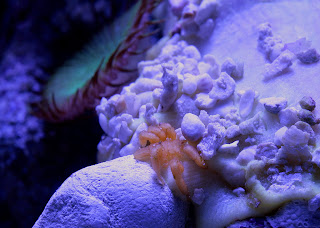Yesterday, I added a large live rock to the main tank. The rock was in quarantine for 6 weeks because it came from a tank that had an outbreak of fish parasites. It took me hours and hours to move corals out of the way and get the rock situated. I tried my best not to break corals and scratch the acrylic walls of the tank. But, it was not easy to avoid.
With the new arrangement, I wanted to move one of the Vortech pumps higher up to provide more water flow in the tank. In doing so, I changed the dynamics of the tank and had to rearrange other corals that might not like as much flow.
I still can't find a good place for my red Gonipora!
Moving corals is like playing a game of chess. You must strategically place your pieces and decide which ones you value the most. And, if you're not careful, a pawn (a colony of zoanthids) can easily take your queen (Acropora).
Rather thank taking pictures of the boring live rock, here are some shots of the right and left side of the tank.
With the new arrangement, I wanted to move one of the Vortech pumps higher up to provide more water flow in the tank. In doing so, I changed the dynamics of the tank and had to rearrange other corals that might not like as much flow.
I still can't find a good place for my red Gonipora!
Moving corals is like playing a game of chess. You must strategically place your pieces and decide which ones you value the most. And, if you're not careful, a pawn (a colony of zoanthids) can easily take your queen (Acropora).
Rather thank taking pictures of the boring live rock, here are some shots of the right and left side of the tank.

This purple Acropora nana is about 6-7" high and attached to a 3" high rock. I found a new place for it, but in the process, I broke off some tips and tore off tissue from the main branch. I'll have to wait and see if it recovers or goes the STN or RTN route that usually strikes less robust corals.












